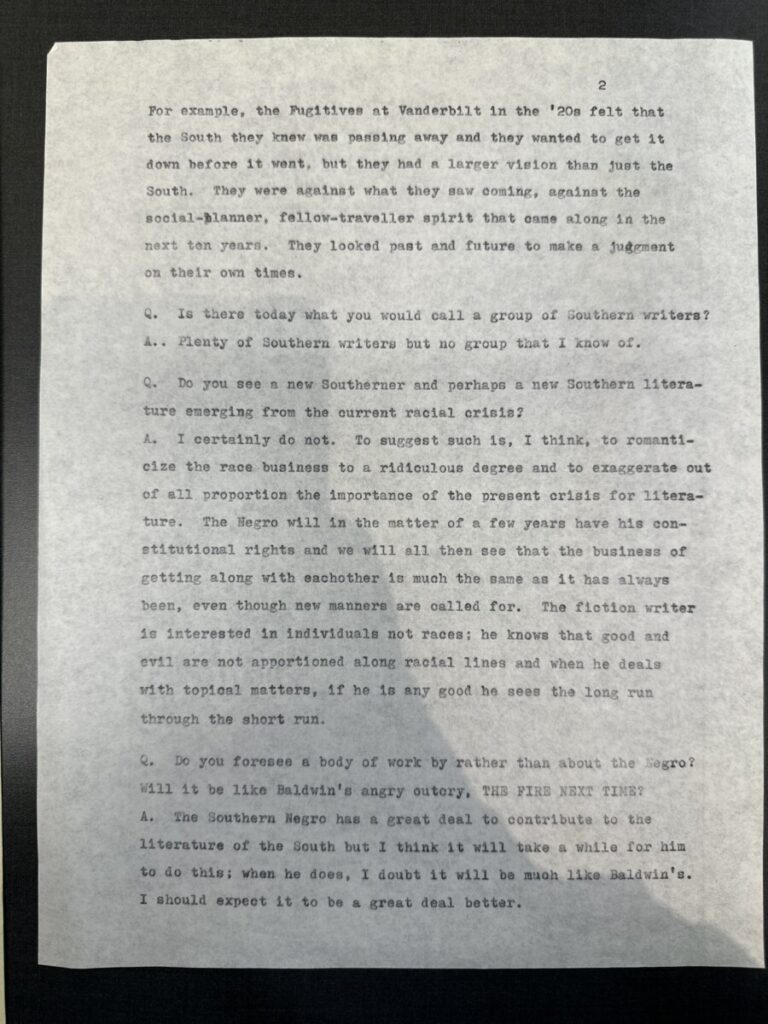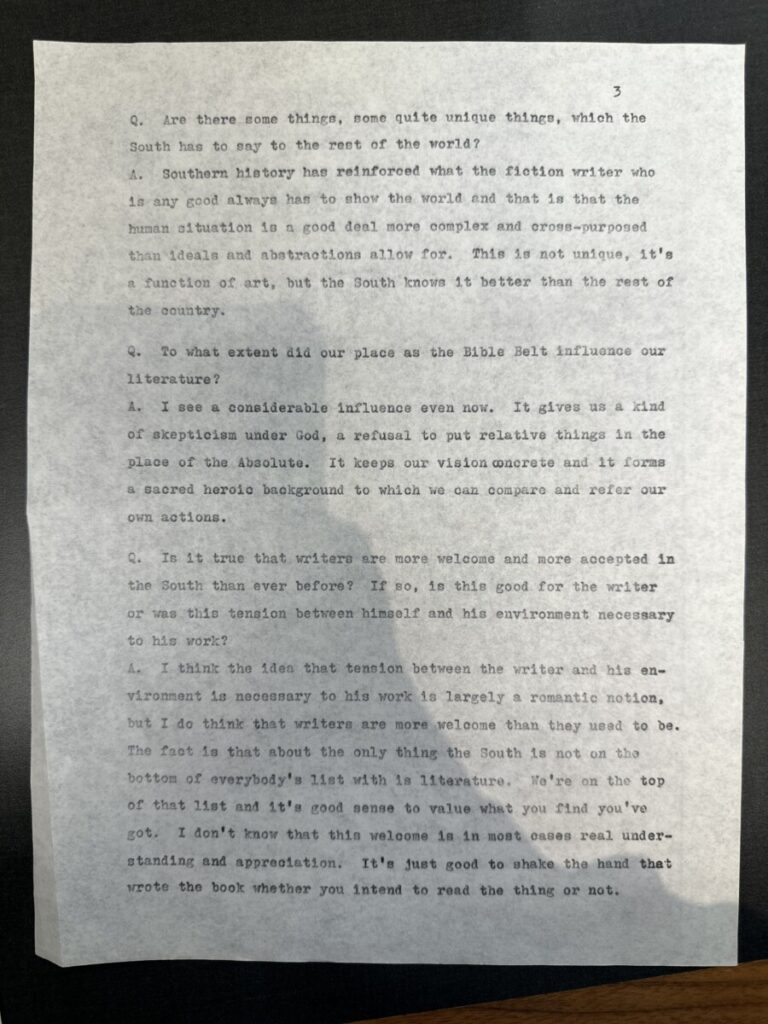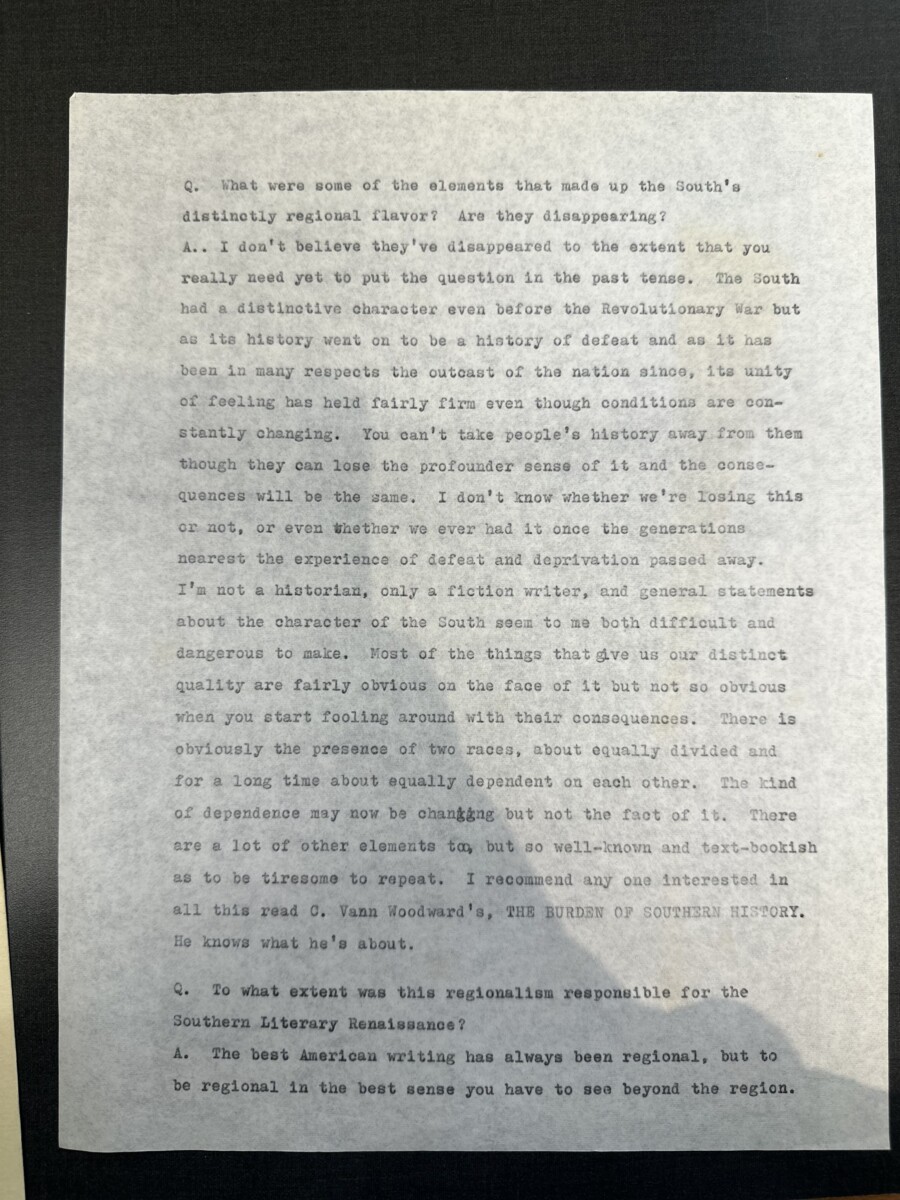After the American Civil War, the majority of Southern literary writers focused their pieces on the South’s past. It evoked a sense of nostalgia that was hard to move past. In the 1920s, a movement known as the Southern Renaissance came into action. The objective was not to forget, but to come to terms with the South’s past. A lot of the writings began to acknowledge the racial tensions present and how they had become a part of the South’s identity. Along with this change in themes, many would write to show the development of the South and give it more meaning than just the South from the Civil War1.
One of the many great writers that came from the South was Flannery O’Connor. She was born on March 25, 1925 in Savannah, Georgia. She attended Georgia State College for Women where she was an editor for the college’s literary magazine, and also drew cartoons for the campus newspaper. O’Connor graduated from the University of Iowa after receiving a journalism scholarship from them in 1945. She used her opportunity to attend the university and contact Paul Engle to pursue a master’s degree in creative writing. Her work often focused on themes relating to the American South and religion. Well-known authors at the time like William Faulkner were who many southern writers were influenced by. Although this was true for Flannery O’Connor’s writing, she did fiction writing that was different from Faulkner’s reality of the South2.
Flannery O’Connor’s career developed during times when Southern literature was going through the most changes it had seen. Even with the whole community taking new similar paths on how to approach the new literary scene in the South, her work still differed from a lot of writers during the Southern Renaissance. As mentioned earlier, O’Connor was huge on faith, she grew up Catholic and that did not change throughout her life. She wrote her characters to reflect on the past and how that got them to where they are in the present and left a lot of what the future would be to God. Unlike other religious southern writers, O’Connor had a belief that God looks out for anyone, even those who did not have faith. Like the objective of the Southern Renaissance, her characters were written to be unique, have faith, and develop character by reflecting on their past. She represented this in her writing by keeping Southern literary traditions such as rhetoric but making it her style3.
Now that it has been introduced who Flannery O’Connor was and her contribution to the Southern Renaissance, a look can be taken at more personal takes from her during that time. Found at the Stuart A. Rose Manuscript, Archives, and Rare Book Library at Emory University, is a draft fragment of an interview by an unnamed person with Flannery O’Connor in the Flannery O’Connor Papers. It is a typescript draft that is undated, and titled “Interview on the Southern Literary Renaissance”. Although there is no date provided, based on the information in the draft, it is before the passing of the Civil Rights Act but after the 1960s (The Burden of Southern History was published in 1960, the book mentioned in the draft).



The typescript consists of eight different questions asked to Flannery O’Connor regarding the Southern Renaissance. All questions asked were great in my opinion, but there are three that I would specifically like to look further into. Starting strong is the first question that is presented in the typescript, “What were some of the elements that made up the South’s distinctly regional flavor? Are they disappearing?” There are three things that I would like to note from her response to this question. The first two are “You can’t take people’s history away from them…” and “There is the presence of two races, about equally divided and for a long time about equally dependent on each other.” Her response to the first question is a good representation of how the Southern writers began to acknowledge the racial tensions that had become a part of the South’s identity. Her response reflects what can be seen in her writings, on how people should reflect on their past. She believes the South should stay true to its identity, but its past is also what has shaped its identity. The third thing that should be noted is her directing the interviewer to read C. Vann Woodward’s The Burden of Southern History. In this book, Woodward talks about the relationship between Southern identity and its uniqueness in forming its history4. She directs the interviewer to this book to avoid making any general statements as she calls herself “only a fiction writer”.
The next question, “Are there some things, some unique things, which the South has to say to the rest of the world?” seems to tackle the idea of the renaissance which led writers in the South to think more about what made the south unique and how it wasn’t just a region of the United States. Before this literary renaissance, H.L. Mencken called out Southern writers for writing worse after the Civil War. This led to the beginning of many more being critical of Southern literature. It prompted Southern writers to explore their Southern identity more and discover what it was that made them unique from the rest of the country5. In her response to the interview question, it seems that O’Connor believes that due to Southern history, a good fiction writer understands that it’s not a unique thing to understand the complexity of a human situation. Rather, it is unique how well they are at showing that in their writing in comparison to other parts of the world.
The last question to take a look at is “To what extent did our place as the Bible Belt influence our literature?” One of the characteristics of the South has always been how religious they are hence the mention of the Bible Belt6. O’Connor keeps her answer short but states, “It keeps our vision concrete…” Even in terms of religion, the recurring theme is staying true to their Southern identity. Religion has always been a part of who they are and should remain like that.
This typescript draft does an adequate job of capturing what the Southern Renaissance meant to a lot of writers and its objective. There are plenty of Southern writers who contributed to this movement, but it is refreshing to have Flannery O’Connor’s work and how it was unique but still true to what the South is.
- Amy Berke, Doug Davis, Jordan Cofer, Robert Bleil, “5:13: Southern Renaissance – First Wave (1920-1940)” in Writing the Nation: A Concise Guide to American Literature 1865 to Present. (University of North Georgia Press, 2015). ↩︎
- Sarah Gordon, “Flannery O’Connor,” New Georgia Encyclopedia, last modified August 3, 2023.https://www.georgiaencyclopedia.org/articles/arts-culture/flannery-oconnor/ ↩︎
- Louise Blackwell, “Flannery O’ Connor and the Southern Renaissance,” in Revista de Letras Vol. 17 (1975), 101–5. ↩︎
- William E. Leuchtenburg and C. Van Woodward, The Burden of Southern History (Baton Rouge: Louisiana State University Press, 2008.) ↩︎
- Edward S. Shapiro, “The Southern Agrarians, H. L. Mencken, and the Quest for Southern Identity,” American Studies Vol. 13 No. 2 (Fall 1972): 75-92, https://www.jstor.org/stable/40641078 ↩︎
- The Bible Belt is an expression that refers to a region in the South that is known for being more evangelical and conservative than the rest of the United States. ↩︎
Bibliography
Berke, Amy, Davis, Doug, Cofer, Jordan, and Bleil, Robert. “5:13: Southern Renaissance – First Wave (1920-1940).” In Writing the Nation: A Concise Guide to American Literature 1865 to Present. University of North Georgia Press, 2015. https://human.libretexts.org/Bookshelves/Literature_and_Literacy/Book%3A_Writing_the_Nation_-_A_Concise_Introduction_to_American_Literature_1865_to_Present_(Berke_Bleil_and_Cofer)/05%3A_Modernism_(1914_-_1945)/5.13%3A_Southern_Renaissance__First_Wave_(1920__1940)
Blackwell, Louise. “Flannery O’ Connor and the Southern Renaissance.” Revista de Letras Vol.17 (1975): 101–5. http://www.jstor.org/stable/27666204.
Flannery O’Connor Papers. Stuart A. Rose Manuscript, Archives, and Rare Book Library, Emory University, Atlanta, GA. 12 October 2023.
Gordon, Sarah. “Flannery O’Connor.” New Georgia Encyclopedia, last modified Aug 3, 2023. https://www.georgiaencyclopedia.org/articles/arts-culture/flannery-oconnor/
Leuchtenburg, William E., and C. Vann Woodward. The Burden of Southern History. Baton Rouge: Louisiana State University Press, 2008. muse.jhu.edu/book/16566.
Shapiro, Edward S. “The Southern Agrarians, H. L. Mencken, and the Quest for Southern Identity.” American Studies Vol.13, No. 2 (1972): 75–92. http://www.jstor.org/stable/40641078.
